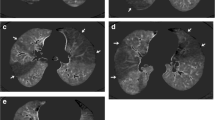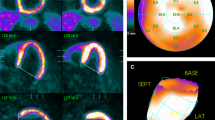Abstract
Purpose
This study sought to evaluate an imaging approach using [15O]H2O and positron emission tomography (PET) for simultaneous assessment of myocardial perfusion, cardiac function and lung water content as a potential indicator of pulmonary oedema.
Methods
Twenty-six subjects divided into two groups (group I, 13 patients with idiopathic dilated cardiomyopathy; group II, 13 healthy volunteers) underwent dynamic PET scanning after intravenous infusion of ≈995 MBq [15O]H2O. In both groups, echocardiograms were performed after the PET studies. From the dynamic [15O]H2O data, lung water content (LWC) at equilibrium, myocardial blood flow (MBF), cardiac output (CO), stroke volume (SV) and stroke volume indexes (SVI) using the indicator dilution principle were determined.
Results
LWC was 18% (p = 0.038) higher in patients than in controls. Global MBF did not differ significantly between the groups, but regional MBF values were significantly lower (p < 0.05) in the anterior and septal walls in the patient group. The results of the Passing-Bablok regression indicated the absence of a systematic difference between the two techniques. Bland-Altman analysis performed for each group (patients vs healthy controls) showed a non-significant bias (p > 0.1) of −0.02 ± 0.82 vs −0.05 ± 0.54 l/min (CO), −1.44 ± 14.31 vs 1.70 ± 10.56 ml/beat (SV) and 0.47 ± 6.21 vs 0.30 ± 5.02 ml/beat/m2 (SVI). The 95% limits of agreement were −1.62 to 1.59 vs −1.11 to 1.01 l/min (CO), −26.61 to 29.49 vs −22.39 to 18.99 ml/beat (SV) and −11.69 to 12.88 vs −9.53 to 10.14 ml/beat/m2 (SVI). Right ventricular CO was increased by 33% (p = 0.014) in the patient group as compared with normal controls.
Conclusion
Our results demonstrate that additional analysis of cardiac function and lung water content are feasible from the dynamic cardiac [15O]H2O PET studies acquired for myocardial perfusion. The parameters appear to work as expected. Further studies are warranted to elucidate the clinical value of these new parameters.







Similar content being viewed by others
References
Kaufmann PA, Camici PG. Myocardial blood flow measurement by PET: technical aspects and clinical applications. J Nucl Med 2005;46(1):75–88.
Rimoldi OE, Camici PG. Positron emission tomography for quantitation of myocardial perfusion. J Nucl Cardiol 2004;11(4):482–90.
Stolen KQ, Kemppainen J, Kalliokoski KK, Hallsten K, Luotolahti M, Karanko H, et al. Myocardial perfusion reserve and peripheral endothelial function in patients with idiopathic dilated cardiomyopathy. Am J Cardiol 2004;93(1):64–8. Jan.
Kalliokoski KK, Nuutila P, Laine H, Luotolahti M, Janatuinen T, Raitakari OT, et al. Myocardial perfusion and perfusion reserve in endurance-trained men. Med Sci Sports Exerc 2002;34(6):948–53.
Ahn JY, Lee DS, Lee JS, Kim SK, Cheon GJ, Yeo JS, et al. Quantification of regional myocardial blood flow using dynamic H2(15)O PET and factor analysis. J Nucl Med 2001;42(5):782–7.
Lee JS, Lee DS, Ahn JY, Cheon GJ, Kim SK, Yeo JS, et al. Blind separation of cardiac components and extraction of input function from H(2)(15)O dynamic myocardial PET using independent component analysis. J Nucl Med 2001;42(6):938–43.
Hermansen F, Ashburner J, Spinks TJ, Kooner JS, Camici PG, Lammertsma AA. Generation of myocardial factor images directly from the dynamic oxygen-15-water scan without use of an oxygen-15-carbon monoxide blood-pool scan. J Nucl Med 1998;39:1696–702.
Lange NR, Schuster DP. The measurement of lung water. Crit Care 1999;3(2):R19–24.
Loening AM, Gambhir SS. AMIDE: a free software tool for multimodality medical image analysis. Mol Imaging 2003;2(3):131–7.
Schuster DP, Mintun MA, Green MA, Ter-Pogossian MM. Regional lung water and hematocrit determined by positron emission tomography. J Appl Physiol 1985;59:860–8.
Velazquez M, Haller J, Amundsen T, Schuster DP. Regional lung water measurements with PET: accuracy, reproducibility, and linearity. J Nucl Med 1991;32:719–25.
Iida H, Rhodes C, de Silva R, Araujo LI, Bloomfield PM, Lammertsma AA, et al. Use of the left ventricular time-activity curve as a noninvasive input function in dynamic oxygen-15-water positron emission tomography. J Nucl Med 1992;33:1669–77.
Iida H, Kanno I, Takahashi A, Miura S, Murakami M, Takahashi K, et al. Measurement of absolute myocardial blood flow with H2 15O and dynamic positron-emission tomography: strategy for quantification in relation to the partial-volume effect. Circulation 1988;78:104–15.
Chen EQ, MacIntyre WJ, Fouad FM, Brunken RC, Go RT, Wong CO, et al. Measurement of cardiac output with first-pass determination during rubidium-82 PET myocardial perfusion imaging. Eur J Nucl Med 1996;23:993–6.
Hove JD, Kofoed KF, Wu HM, Holm S, Friberg L, Meyer C, et al. Simultaneous cardiac output and regional myocardial perfusion determination with PET and nitrogen 13 ammonia. J Nucl Cardiol 2003;10(1):28–33.
Sorensen J, Stahle E, Langstrom B, Frostfeldt G, Wikstrom G, Hedenstierna G. Simple and accurate assessment of forward cardiac output by use of 1-(11)C-acetate PET verified in a pig model. J Nucl Med 2003;44(7):1176–83.
Frostfeldt G, Sorensen J, Lindahl B, Valind S, Wallentin L. Development of myocardial microcirculation and metabolism in acute ST-elevation myocardial infarction evaluated with positron emission tomography. J Nucl Cardiol 2005;12(1):43–54.
Passing H, Bablok W. A new biometrical procedure for testing the equality of measurements from two different analytical methods. Application of linear regression procedures for method comparison studies in clinical chemistry, part i. J Clin Chem Clin Biochem 1983;21:709–20.
Bland JM, Altman DG. Statistical methods for assessing agreement between two methods of clinical measurement. Lancet 1986;1(8476):307–10.
Chareonthaitawee P, Kaufmann PA, Rimoldi O, Camici PG. Heterogeneity of resting and hyperemic myocardial blood flow in healthy humans. Cardiovasc Res 2001;50(1):151–61.
Acknowledgements
We are grateful to the technical staff from the Turku PET Centre for their assistance during the acquisition and analysis of the PET data sets.
Author information
Authors and Affiliations
Corresponding author
Additional information
This study was financially supported by grants from Turku University Hospital (EVO) and Finnish Foundation for Cardiovascular Research.
Rights and permissions
About this article
Cite this article
Naum, A., Tuunanen, H., Engblom, E. et al. Simultaneous evaluation of myocardial blood flow, cardiac function and lung water content using [15O]H2O and positron emission tomography. Eur J Nucl Med Mol Imaging 34, 563–572 (2007). https://doi.org/10.1007/s00259-006-0259-3
Received:
Accepted:
Published:
Issue Date:
DOI: https://doi.org/10.1007/s00259-006-0259-3




